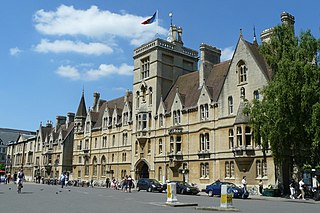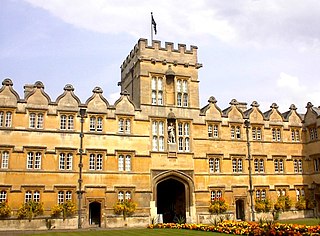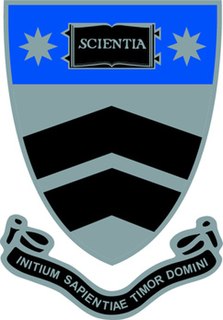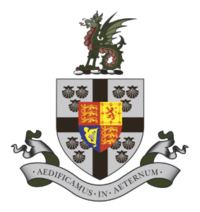
Trinity College is a constituent college of the University of Cambridge in England. With around 600 undergraduates, 300 graduates, and over 180 fellows, it is the largest college in either of the Oxbridge universities by number of undergraduates. In terms of total student numbers, it is second only to Homerton College, Cambridge.

Balliol College is one of the constituent colleges of the University of Oxford in England. One of Oxford's oldest colleges, it was founded around 1263 by John I de Balliol, a rich landowner from Barnard Castle in County Durham, who provided the foundation and endowment for the college. When de Balliol died in 1269 his widow, Dervorguilla, a woman whose wealth far exceeded that of her husband, continued his work in setting up the college, providing a further endowment, and writing the statutes. She is considered a co‑founder of the college.

Hertford College is a constituent college of the University of Oxford in England. It is located on Catte Street in the centre of Oxford, directly opposite the main gate to the Bodleian Library. The college is known for its iconic bridge, the Bridge of Sighs. There are around 600 students at the college at any one time, comprising undergraduates, graduates and visiting students from overseas.

The Queen's College is a constituent college of the University of Oxford, England. The college was founded in 1341 by Robert de Eglesfield (d'Eglesfield) in honour of Queen Philippa of Hainault. It is distinguished by its predominantly neoclassical architecture, which includes buildings designed by Sir Christopher Wren and Nicholas Hawksmoor.

University College is a constituent college of the University of Oxford in England. It has a claim to being the oldest college of the university, having been founded in 1249 by William of Durham.

Flinders University is a public university in Adelaide, South Australia. Founded in 1966, it was named in honour of British navigator Matthew Flinders, who explored and surveyed the South Australian coastline in the early 19th century.

Queens' College is a constituent college of the University of Cambridge, England. Queens' is one of the oldest and the largest colleges of the university, founded in 1448 by Margaret of Anjou, and has some of the most recognisable buildings in Cambridge. The college spans the river Cam, colloquially referred to as the "light side" and the "dark side", with the Mathematical Bridge connecting the two.

Ormond College is the largest of the residential colleges of the University of Melbourne located in the city of Melbourne, Victoria, Australia. It is home to around 350 undergraduates, 90 graduates and 35 professorial and academic residents.

New College, University of New South Wales is a residential college, located in the UNSW campus in Sydney. The college is organised around on Anglican principles. About 250 undergraduate students, both local and international and of a variety of backgrounds, live in the original college building, and 315 graduate students are housed in the nearby New College Village. New College is also home to the Centre for Christian Apologetics, Scholarship and Education (CASE) which specialises in Christian apologetics.

Newman College is a Roman Catholic co-educational residential college affiliated with the University of Melbourne. During the university year it houses about 200 undergraduate students and about 80 postgraduate students and tutors. The college was named after Cardinal John Henry Newman, a former Anglican and major figure in the Oxford Movement who became a Roman Catholic in the 19th century. The college continues to commemorate the life of Newman through events such as the "Cardinal Newman Dinner" and the prominent positioning of his portrait in the dining hall. Although most strongly affiliated with the University of Melbourne, a small number of undergraduate students attend RMIT University, Monash University's Parkville and City campuses, and the Australian Catholic University.

Janet Clarke Hall (JCH) is an Anglican residential college of the University of Melbourne. JCH is one of the smallest of the colleges of the University of Melbourne, and was the first university college in Australia to admit women. JCH has a strong academic focus, with a plurality of students in residence achieving a first class average in their university studies.
Edward Holdsworth Sugden was the first master of Queen's College. He was, in partnership with the Methodist Church, responsible for laying down the foundings of the college including the Sugden Principle.

Warrane College UNSW is an affiliated residential college at the University of New South Wales, Australia. The name of the College is derived from the Aboriginal word for the Sydney Cove area, "Warrang", highlighting the recognition by Warrane and UNSW of Australia's indigenous people as original inhabitants of land on which they are located.

St Hilda's College is a college of The University of Melbourne, providing a residential community for students from all parts of regional Victoria, interstate and overseas. It provides accommodation, academic and pastoral support for 210 undergraduate students and 10 graduate students. 15 Residential tutors are also accommodated in the College.

Sarum College is an ecumenical Christian institution in Salisbury, England. The college was established in 1995 and is the successor of the Salisbury and Wells Theological College. It sits within the Cathedral Close on the north side of Salisbury Cathedral.

Wesley House was founded as a Methodist theological college in Jesus Lane, Cambridge, England. It opened in 1921 as a place for the education of Methodist ministers and today serves as a gateway to theological scholarship for students and scholars of the Wesleyan and Methodist traditions from around the world. It was a founding member of the Cambridge Theological Federation, an ecumenical body of theological colleges in Cambridge which is affiliated to but independent of the University of Cambridge.

The United Theological College located in Aberystwyth, in the county of Ceredigion in mid Wales, was the ministerial training college of the Presbyterian Church of Wales from 1906 to 2003 and an associate college of the University of Wales. According to the Cardiganshire County History, 'Theol Coll' opened in Aberystwyth in 1906 on the seafront site of the former Customs House. This in turn was demolished and the stone-built Cambrian Hotel was built on the site in 1896 to the design of George Croydon Marks, engineer to the Aberystwyth Improvement Company.

Philip Ridgeway "Pip" Le Couteur was an Australian academic, philosopher and headmaster.
Lawrence Richard Dimond Pyke was an Australian headmaster and university dean. Referred to in print as LRD Pyke, this led to his nickname of "Lardy".



























